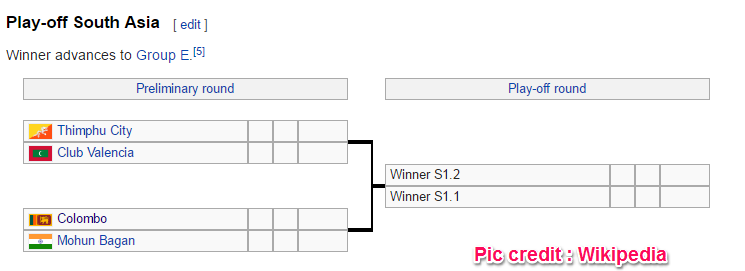
Guru Prasad, a football enthusiast from Bengaluru takes a closer look at the new format of AFC Cup.
You can follow him on twitter here.
When AFC came out with a new format for the AFC Cup, there were some reports in the media about how the revamped format will be beneficial for Indian clubs participating in the continental championship. However, a closer look at the revamped format reveals that instead of it being beneficial for our clubs, it could turn out to be detrimental for them and in turn it could also take a hit on the member association (MA rankings) for India. MA rankings are used by AFC to determine the number of slots a country gets in the continental championships, the AFC Cup and the AFC Champions league.
First let us take a look at the new format. Starting from 2017, instead of the two zones, clubs are going to be divided into five zones – West Asia, Central Asia, South Asia, East Asia and ASEAN. A total of 36 clubs will be competing from these zones. Each zones are allocated teams through direct slots and through play offs. Slot allocation for the five zones are as follows:
West Asia Zone : 9 direct/3 from play-offs = 12 teams (Three groups)
ASEAN Zone : 9 direct/3 from play-offs = 12 teams (Three groups)
Central Asia Zone : 3 direct/1 from play-offs = 4 teams (One group)
East Asia Zone : 3 direct/1 from play-offs = 4 teams (One group)
South Asia Zone : 3 direct/1 from play-offs = 4 teams (One group)
As you can see all South Asian teams comes under one group. That means, Bengaluru FC (should they drop-down to AFC Cup without reaching the group stages of AFC Champions League), will be joined by Maziya from Maldives and Abhani Limited of Bangladesh. The fourth spot in the group will be taken by the winners of the play-off round in South Asia.
This is how the play off round for the south Asia looks like :
Federation Cup winners Mohun Bagan will have to play two matches against South Asian teams to even reach the group stage of the competition (No MA points are accrued for prelims and Play-off matches). Now, compare this with the AFC Cup format of 2016, where both teams from India – Mohun Bagan and Bengaluru FC were placed in two different groups (Group G & H)and had a chance to go further in the competition. Whereas in 2017 they will be fighting with each other in the same group, if Bagan qualify for the group stages. And only one team, that is either Bengaluru FC or Mohun Bagan will be progressing to the further stages of the competition.
Now take a look at the West Asian Zone, they have 3 groups in the zone and the teams are dispersed in these groups. For example, Air Force Club of Iraq who were the 2016 AFC Cup champions after defeating Bengaluru FC is placed in Group B of West Zone and Al Zawraa another club from Iraq is placed in Group A, offering the two teams a chance to progress further in the tournament. ASEAN zone is another one with an unfair advantage over others. ASEAN zone has 3 groups and teams from these countries are dispersed among these groups. AFC cup 2016 semi finalists Johor Darul Ta’zim is in Group F of the competition, whereas another Malaysian team Felda United is placed in Group G. The only thing good coming out of this format revamp is that there will be representation from more countries in AFC Cup and probably lesser miles traveled by teams to play the away matches.
The MA ranking conundrum
With the new format in place, the MA rankings of India could take hit too. Lets us take a look.
if 2 or more teams participate from the same MA, then their points get averaged out and if one team is good but others are not good, then the points gained by MA is not good (e.g. For Malaysia, last year where JDT reached semifinal, but other team crashed out of group stage taking their points gained only to 7.167), this is a shortcoming in AFC’s points calculation mechanism. And it gives advantage to the MA from where only one team is participating and if the participating team performs well in the competition, then MA points gained will be very good. Where as for MAs with more teams, this method proves to be disadvantageous. Because, if MAs with one or more teams participating, then all the teams must perform very well to gain more points, like the case with India last year).
But this year’s format of AFC Cup has aggravated the situation for top MAs in south, central and East zone (with India and Tajikistan being the biggest losers), as one team from one MA will not advance out of group stage, hence points gained will be low for an MA with 2 teams. In addition, AFC cup points only account for 1/3rd that of ACL games. This means India is the biggest loser in this case (If BFC doesn’t go to the group stage of ACL and perform well there) there will be no chance for India to break in to the Top 6 MAs in the region before 2017 November whose rankings will be counted for slot allocations of 2019 and 2020. So, AFC is trying to preserve status quo in ACL slot allocations and West and ASEAN zone in AFC cup and prevent new MAs being represented in ACL. Although not apparent unless you read between the lines and dig deeper on the new format. As per the new format, as a country it is advantageous for us only if one club makes it to the group stage of the tournament. If two of them make it to the group stage, it would be detrimental for our MA rankings. A real catch-22 situation for us!
Also noticeable is that ASEAN and West Asian teams that qualify for further stages play 4 and 2 more games respectively than the rest, if the points accrued in these extra matches also count (zonal Semifinals and zonal finals) then all the other zones are at a serious disadvantage.
This is where it gets utterly tricky for India, if Bengaluru FC doesn’t qualify for ACL and at least doesn’t get till Quarterfinals (pray to god for some miracle!!), then the next window of opportunity for substantial increase in MA rankings and better slot allocation comes only in 2020 whose ranking will probably be counted for 2021 allocations and there is a plan to count only club performance for that, at the moment we can’t say for sure if that it will be beneficial to India as there are countries where National team is below par, but clubs do extremely well.
Status Quoist AFC?
Its looks like AFC isn’t an exception in trying to maintain status quo, there are many world sporting bodies like UEFA (who are trying to change UCL structure to give unusual preference to top MAs), ICC (The Big three control the revenue and administration preventing smaller cricketing nations a greater share of revenue and associate nations with remote chance of playing test matches)etc, and Indian football in tatters due to ongoing restructuring and shutting shops of old clubs also doesn’t help. And AFC being status quoist that it is, Clubs can’t expect too much help from them in the current crisis.
On the whole, the revamped format of the AFC Cup along with the current method of MA ranking calculation, it is quite obvious that India has got a raw deal with the recent format revamp of the AFC Cup. Despite all the challenges our clubs have been facing on the domestic front, performances on the continental level in the AFC Cup has been quite decent from our clubs. This revamp of the competition format is going to cripple our progress in terms of MA rankings and our quest for a direct slot in the AFC champions League. Although Some may say It is too soon to dream about direct slot in ACL, we never know until we are tested rigorously and only then do we have a chance to Improve ourselves.
 I-league 2017 will kickoff on January 7. Here is the fixture list for the first nine rounds and the broadcast details. Ten teams from nine cities will participate in the league this season.
I-league 2017 will kickoff on January 7. Here is the fixture list for the first nine rounds and the broadcast details. Ten teams from nine cities will participate in the league this season.







